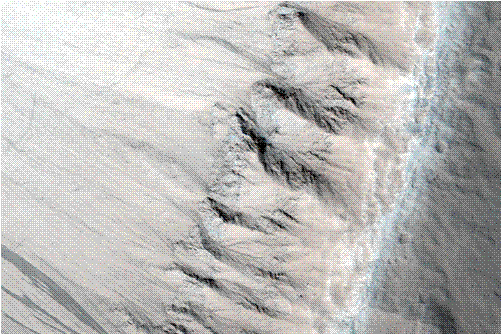The characteristics of the column-like fractures can help scientists understand the role of water in geologic processes on Mars, said Moses Milazzo, a geophysicist with the U. S. Geological Survey Astrogeology Team in Flagstaff and lead author on a paper on the discovery recently published in the journal Geology.
"Columnar joints form as cooling lava contracts," said Milazzo.

This HiRISE image shows a part of a 10-mile-diameter crater near Marte Valles, Mars, where scientists discovered the "jointed" columnar rocks, or joints that formed as cooling lava contracted. (Credit: NASA/JPL/University of Arizona)
Milazzo is a member of the High Resolution Imaging Science Experiment, or HiRISE, on NASA's Mars Reconnaissance Orbiter. HiRISE is operated by The University of Arizona Lunar and Planetary Laboratory. LPL professor Alfred McEwen is principal investigator.
The columns, a meter in diameter and about 30 meters high, or about 3 feet wide by 100 feet high, were identified in the tilted inner walls of an impact crater.
"The HiRISE instrument just barely has the resolution to pick out the columns if they're facing the camera with the perfect orientation," Milazzo said.
When the impact crater formed, the rocks were tilted backward, toward the sky. This tilting of the columns toward the sky is what allowed the identification. The impact crater where the columns were discovered is in a region that has a history of extensive volcanic activity. Milazzo said that he suspects that the columnar joints formed as lava flows were quickly cooled by floods of liquid water.
Milazzo and co-authors suggest that the multiple tiers of columnar joints observed in the crater wall indicate that the Martian lavas were episodically quenched by water. Flooding cycles may have lasted from a few months to a few years.
Here on Earth, columnar joints are common in the rocks of the Colorado Plateau.
"One of my favorite places to see columnar jointing is Grand Falls, on the Navajo reservation, about 45 miles east of Flagstaff," Milazzo said. "If you hike down to the bottom during the dry season, you'll cross some perfect examples of columnar joints, which formed when enormous amounts of water flooded the cooling lava."
The rocks of the Colorado Plateau continue to provide valuable study sites for comparison to Mars.






Comments